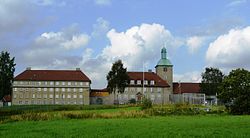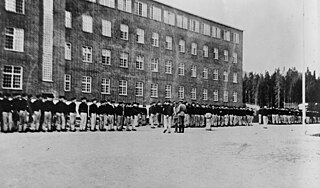
Grini prison camp was a Nazi concentration camp in Bærum, Norway, which operated between 1941 and May 1945. Ila Detention and Security Prison is now located here.
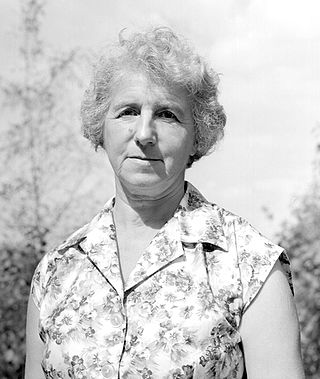
Ingrid Bjerkås was a Norwegian theologian and the first female minister in the Church of Norway.
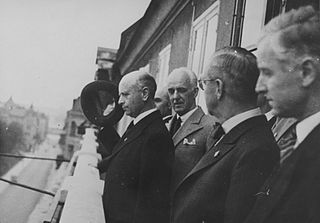
The Norwegian Legation in Stockholm played a significant role during the Second World War. Until 9 April 1940 the legation consisted of four persons, and at the end of the war about 1,100 persons were connected to the legation. Refugee cases were among the legation's most central tasks. In 1941 a military office was established, and this was later split into separate offices for intelligence, and for Milorg related cases.
Milly Elise "Lise" Børsum was a Norwegian resistance member during World War II, survivor from the Ravensbrück concentration camp, and known for her writings and organizing work after the war.

Johan Christian Schreiner was a Norwegian historian. He was a professor at the University of Oslo, and his speciality was the Middle Ages.
Conrad Vogt-Svendsen was a Norwegian priest. He was assistant seamen's priest in Hamburg during Second World War, helped with the White Buses operation in 1945, and was later main priest for the deaf in Norway.
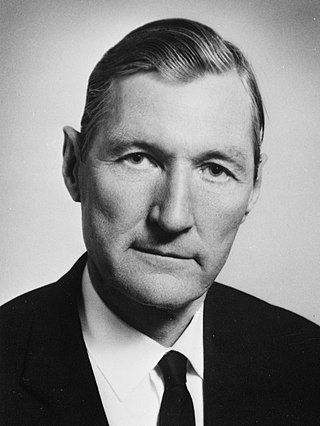
Johannes Bratt Andenæs, often shortened to Johs. Andenæs was a Norwegian jurist. He was a professor of jurisprudence at the University of Oslo from 1945 to 1982, and served as rector from 1970 to 1972.

Alfhild Hovdan was a Norwegian journalist, and later tourist manager for the city of Oslo for more than forty years. She is known for initiating the tradition of the Trafalgar Square Christmas tree, a present from the city of Oslo to the people of London, in recognition of their assistance during World War II.

Trygve Friis Bull was a Norwegian lecturer and politician. He was a member of Mot Dag in the 1920s and 1930s, and contributed to the magazines Mot Dag, Clarté and Kontakt. During World War II he was imprisoned by the Germans, and incarcerated at the Grini and Sachsenhausen concentration camps. He was a politician for the Labour Party, a deputy representative to the Storting from 1957 to 1969, and later a politician for the Socialist Left Party. He was a member of the committee Norsk Språknemnd from its establishment in 1952 until 1972, and Norsk språkråd from 1972 to 1981.
Carl Jacob Arnholm was a Norwegian jurist.
Bjørn Føyn was a Norwegian zoologist, especially known for researching the genetics of algae.

Endre Qvie Berner was a Norwegian organic chemist, author and educator.
Eiliv Skard was a Norwegian classical philologist.
Harald Krabbe Schjelderup was a Norwegian physicist, philosopher and psychologist. He worked with all three subjects on university level, but is best remembered as Norway's first professor of psychology.

Anatol Heintz was a Russo-Norwegian palaeontologist.
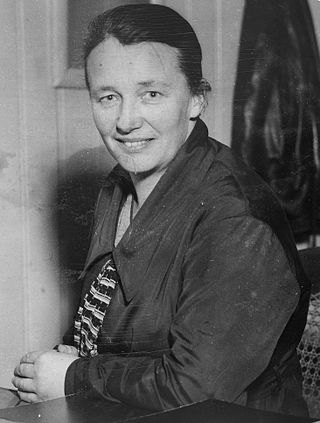
Aaslaug Aasland was a Norwegian politician for the Labour Party. She served as Norwegian Minister of Social Affairs from 1948 to 1953.

Bredtvet is a neighborhood in the borough of Bjerke in Oslo, Norway.
Odd Lindbäck-Larsen was a Norwegian military officer and war historian. He participated in the Norwegian Campaign in Northern Norway during the Second World War as the chief-of-staff, under general Fleischer. He spent most of the war in Norwegian and German concentration camps. He continued his military career after the war, eventually with the rank of major general and military attaché in Stockholm. He wrote several books on Norwegian military history.

Ila prison and detention center is a high security prison in Ila in Bærum municipality in Akershus county, outside the capital city of Oslo in Norway. It is the national preventive detention facility for men in Norway, i.e. the prison for men serving preventive detention (forvaring), Norway's maximum penalty. Ila generally houses the most dangerous criminals in Norway, who are convicted of violent and sexual crimes.
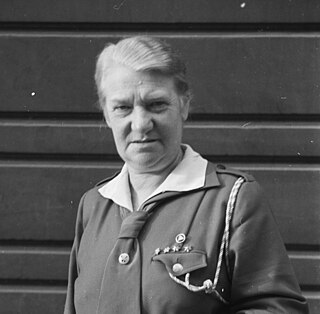
Margrethe Parm (1882–1966) was a Norwegian Christian leader, teacher, scout leader and prison director. She founded Norway's YWCA Scouts in 1920.
